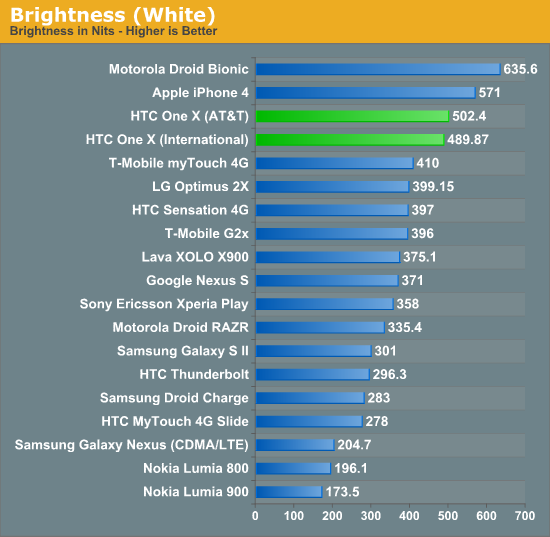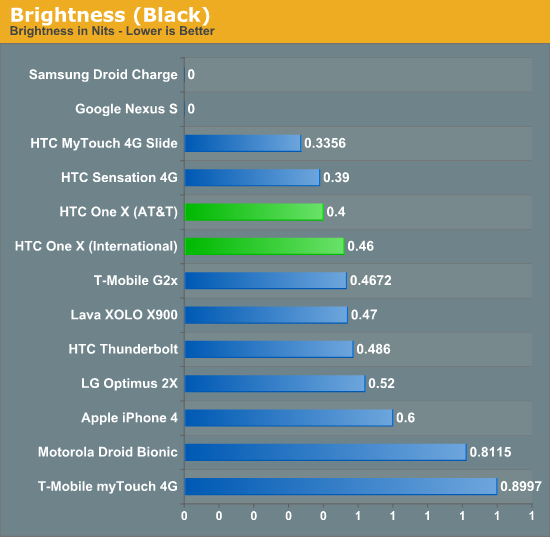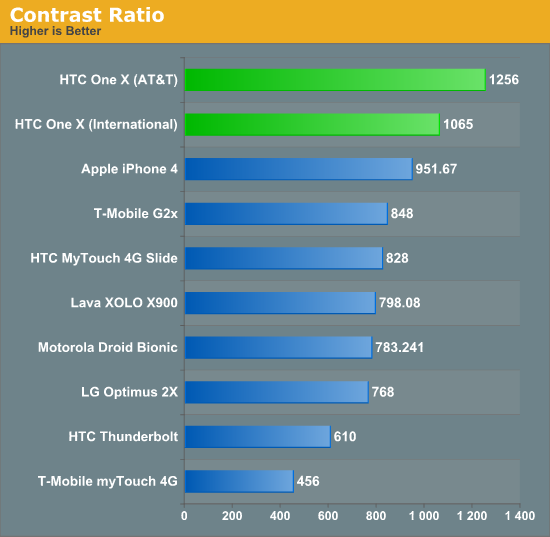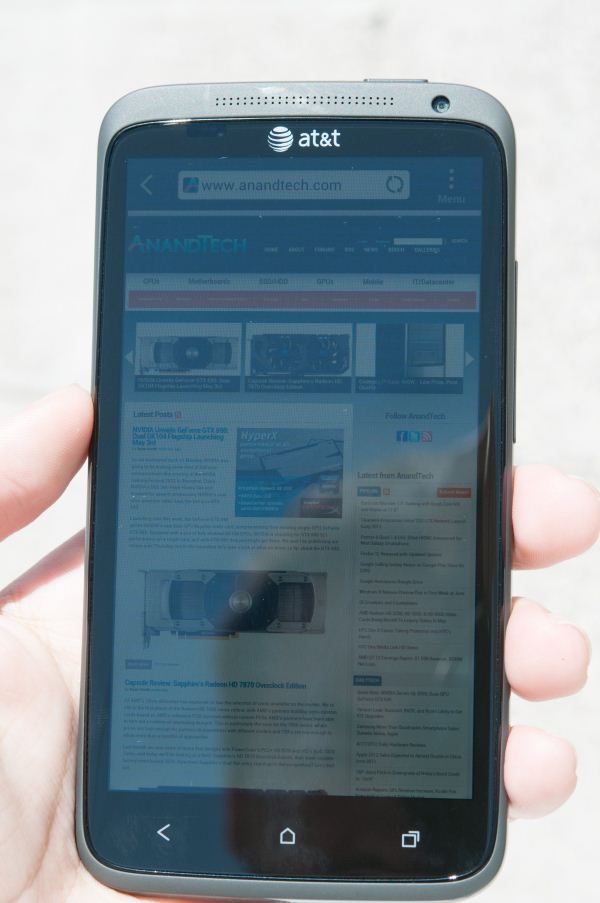The HTC One X for AT&T Review
by Brian Klug on May 1, 2012 6:00 PM EST- Posted in
- Smartphones
- Snapdragon
- HTC
- Qualcomm
- MSM8960
- Krait
- Mobile
- Tegra 3
- HTC One
- NVIDIA
The One X has a 4.7“ 1280x720 display that’s beautiful, dubbed the ”infinity screen.“ In fact, that’s really all you need to know about it - it’s absolutely wonderful, and honestly if you’re concerned with mobile displays just stop right there. At above 4.5” diagonal, 720p seems to be the new norm, and the combination of that 4.7" diagonal size and 720p on the HTC One X results in a PPI of 312. HTC shipped a device with an LCD display last year whose pixel density exceeded the iPhone 4/4S Retina Display for the first time in the HTC Rezound, which was 341 PPI.
Nevertheless the HTC One X still has subpixels small enough that I can’t visually distinguish them at all but from the most extreme distances. In addition, because it’s LCD you get an RGB stripe as opposed to PenTile RGBG like what currently ships on Samsung’s SAMOLED HD displays at 720p in the Galaxy Nexus.
I did some poking around, and my HTC One X (AT&T) review unit has a Sony display:
[DISP] mipi_video_sony_hd720p_init: assign initial setting for SONY_NT id 0x18103 Cut1, PANEL type = PANEL_ID_ELITE_SONY_NT



The panel goes extremely bright, at over 500 nits maximum, and has top of the chart contrast. As always I characterized the One X display using a combination of ColorHCFR and an i1D2 and Francois’ excellent Voodoo Screen Test Pattern generator application.
I’ve made both the color.chc file and measures available. The CIE diagram shows that HTC’s Infinity Display has very close to sRGB coverage, however color temperature is on the red side at just under 6000K. That’s really my only gripe, and curiously enough the One S with SAMOLED qHD displays are closer to 6500K than the LCD packing HTC One Xes.
Viewing angles look good on the HTC One X, there's no visible color shift at extreme angles. Outdoor viewing is also pretty good on the HTC One X, thanks in part to optical bonding between the display glass and LCD itself. One fewer air gap means fewer Fresnel reflections which quickly turn a display into a mess outdoors.
























137 Comments
View All Comments
snoozemode - Tuesday, May 1, 2012 - link
The RGBW in the Atrix is still bad though except for battery performance which is better because of more light coming through.snoozemode - Tuesday, May 1, 2012 - link
Would be interesting to see battery performance on gps usage, especially on the 8260A and 8960let where the gps is 28nmthat on-die.OCedHrt - Tuesday, May 1, 2012 - link
Does the best wifi performance not affect battery life? I noticed the One X does have worse battery life on wifi.sprockkets - Tuesday, May 1, 2012 - link
I don't know but with it checked on an HTC sensation the battery never charged up and that was on the 1amp charger with the phone. Weird. (this was done on the latest Android Revolution firmware for ICS on the sensation.)OCedHrt - Tuesday, May 1, 2012 - link
Don't they have the same processor w/o the LTE baseband?3DoubleD - Tuesday, May 1, 2012 - link
I know this is less important that the other battery life tests you've done, but it would be interesting if you could include some sort of idle power drain test. For one, it would be interesting to see how the Tegra 3 would compare to the S4 here, since the Tegra 3 has the low power companion core for idle tasks.Also, you included a color accuracy chart it your iPad3 review, could that be added to the display reviews. It's much easier to interpret than looking at the CIE diagram.
Thanks for the great review... I'm pretty tempted to buy a white One X after this. I've been impatiently waiting and refreshing Anandtech for weeks now for this review!
NeoteriX - Wednesday, May 2, 2012 - link
The 40nm LP process used for the companion core may be a bit of a gimmick compared to the next generation smaller process fabs. In other words, it's clear that the 40nm LP process cuts down on consumption compared to the 40nm general process (so, compared with the Tegra 2 which is two cores at 40nm general process, there is battery savings).However, it could very well be (and is likely) that even the 40nm LP process cannot compete with the 28nm fabrication process used in the Snapdragon S4.
It would be interesting to see, but my bet would be that the S4 wins even on idle.
fm123 - Thursday, May 3, 2012 - link
The only thing similar is the phone talk time battery life. Since the Krait has an advantage of 3G/4G integration and die size, the talk function largely removes 3G/4G function from the test (which Tegra does not have integrated), and the talk function itself is not too intensive.Stormkroe - Tuesday, May 1, 2012 - link
I'd like to think that my incessant whining in the mobile forums are responsible for Exynos missing from the glbenchmark charts :) Broken scores, I tell ya!!!PLEASE, as a favor to us old 2011 phone owners, re-review phones like the Sensation and Galaxy S2 now that they've gotten ICS.
RamarC - Tuesday, May 1, 2012 - link
battery life vs capacity is useless if the end user can't replace/expand the battery. it doesn't matter if phone A lasts 7 hours with a smaller battery but phone B lasts 9 hours with a bigger battery. if both batteries are fixed, phone B lasts longer, period. now maybe an overall comparison of phone A vs B with all benchies summarized would be good, but even then cost on the same carrier would need to be considered .